Selcouth Chronicles Week 13
Hello family and friends! Welcome to week 13 of the Selcouth Chronicles.
Week 13: March 31 - April 6
March 27 🛫 Chiang Mai -> 🛬 Bangkok
April 4 🛫 Bangkok -> 🛬 Doha 🛫 ->🛬Istanbul
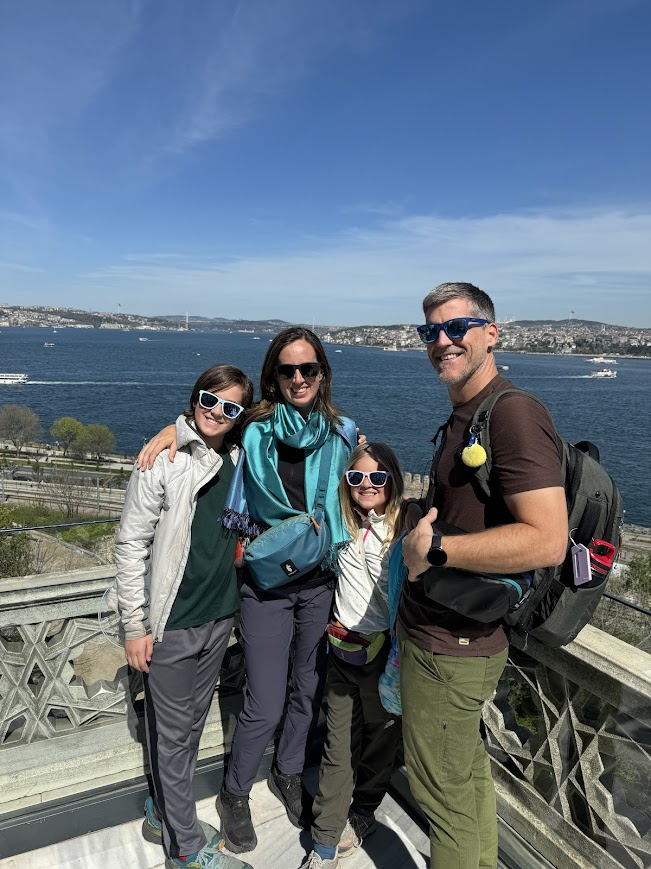
THAILAND & TURKEY
Highlights: Wat Pho and Reclining Buddha, Wat Arun, Jim Thompson silks, Bangkok's Grand Palace, Hagia Sophia, Blue Mosque, Topkapi Palace, Basilica Cistern
Sean:
This week has been a fun combination of the old and the new. Caitlin and I spent our honeymoon in Thailand many moons ago, and bringing the kids back to see it was special. Istanbul, on the other hand, was brand new and really was added as a stopover on our way into Europe, but has found its way into our hearts as a magical stop with amazing history.
We opened the week with an early flight out of Chiang Mai into Bangkok, which left us plenty of time to do some sightseeing immediately. Wat Pho was about a 15 minute walk from the hotel, so we headed over after settling into the rooms. Seeing James and Abby’s eyes go large as they saw the immense Budha image was a lot of fun. The kids also got to drop coins into bowls as a way of bringing luck, so hopefully it works.
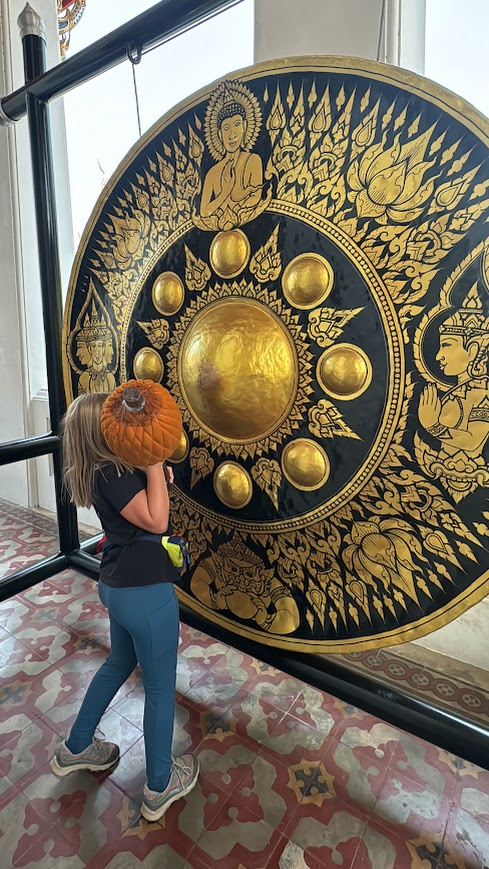
The next day we had a fun breakfast of super thick toast covered in ice cream. One had chocolate and bananas and the other just honey, and it was a decadent way to start the day. From there, we took a long walk to the dock, boarded a boat, and took the very short ride across the river to Wat Arun. The Pauls joined us here and we all enjoyed the sites while trying not to melt in the heat. After the Wat, I returned to the hotel to work, while the kids and Caitlin went with the Pauls to the Jim Thompson house and then swimming to cap off the day.
Tuesday was another busy day, as I got right to work early in the morning, and the rest of the family met the Pauls and their friends the Johnsons at the Museum of Siam. Once I had a break from the computer, I met them at the museum and we continued on to the Golden Buddha. The location of the Golden Budha is right near the entrance of the famous Chinatown in Bangkok, so we took a stroll through and had some dinner at a few different stalls. Here we discovered the hotel that Caitlin and I spent some time in during our honeymoon, which was a fun full circle moment.
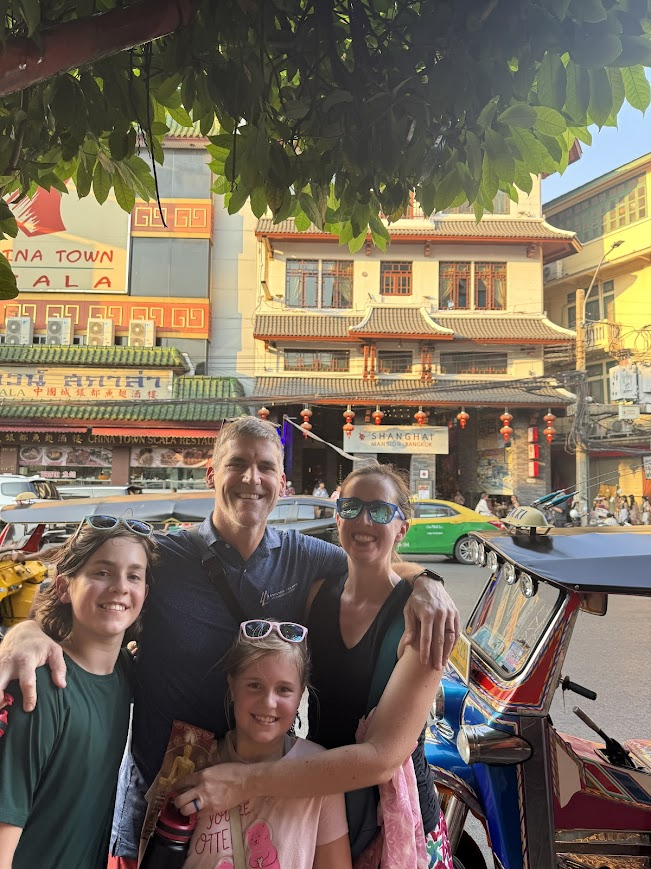
On our last full day in Bangkok, we visited the Grand Palace and the Emerald Buddha (sense a theme?). The Emerald Buddha makes up for its size with its reputation, and we sat for some time while a couple of members of the group sketched the scene. After circling the palace and other buildings, we did laundry, packed up, and prepared to depart Thailand.
Thursday we woke up early to be ready for our 5:30am taxi to the airport and our flight from Bangkok to Doha. A short layover in the Doha airport before our connecting flight to Istanbul, then it was an hour ride from the airport to the Airbnb, totaling 17 hours from Bangkok to bed in Istanbul. We were beat!
Friday morning we took our time getting started and eventually made our way to breakfast at a restaurant suggested by our host. We all really enjoyed that and went back to the Airbnb to do some math. Once we were all up for it, we took a walk to the Hagia Sofia. This is one of the most incredible buildings I’ve ever visited with so much history it’s hard to wrap your head around it. Afterward, we sat in a park while Abby sketched and James had some Turkish ice cream, then a tasty dinner at a restaurant we found and our first day in Istanbul was complete.
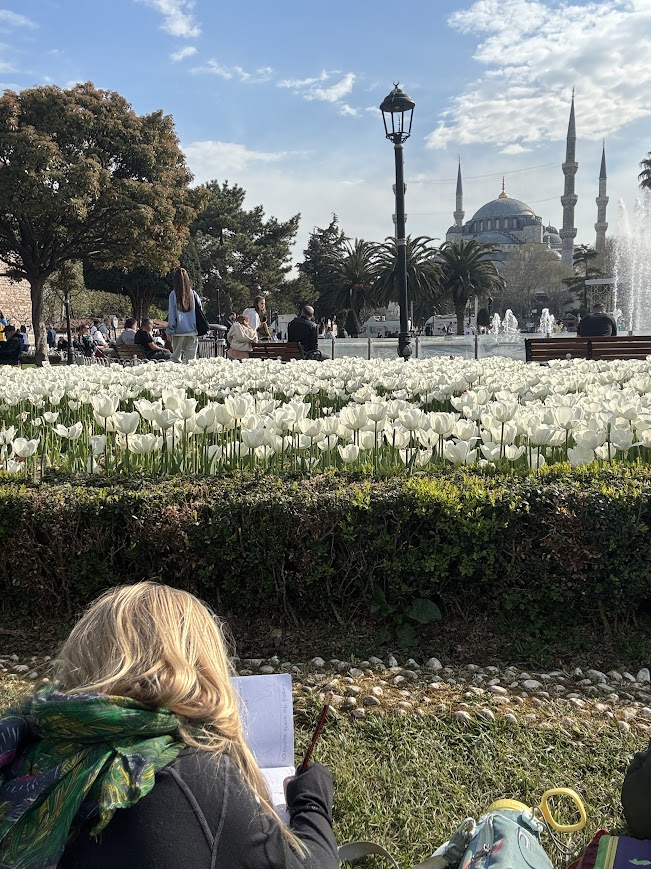
Since we were here for such a short period of time, we opted for a guided tour to maximize our one weekend day. We met our guide Abdullah outside our Airbnb at 10 am and went straight out. In order, we visited the Blue Mosque, Topkapi Palace, the Byzantine Walls, the Basilica Cistern, and the Grand Bazaar. By the end, our feet were sore but we walked away from Istanbul with a real respect for the city. It’s much more than I expected, and would definitely consider returning again in the future.
Abby:
Bangkok is known for its many Buddha statues. This week, I’m writing about three of the most famous ones.
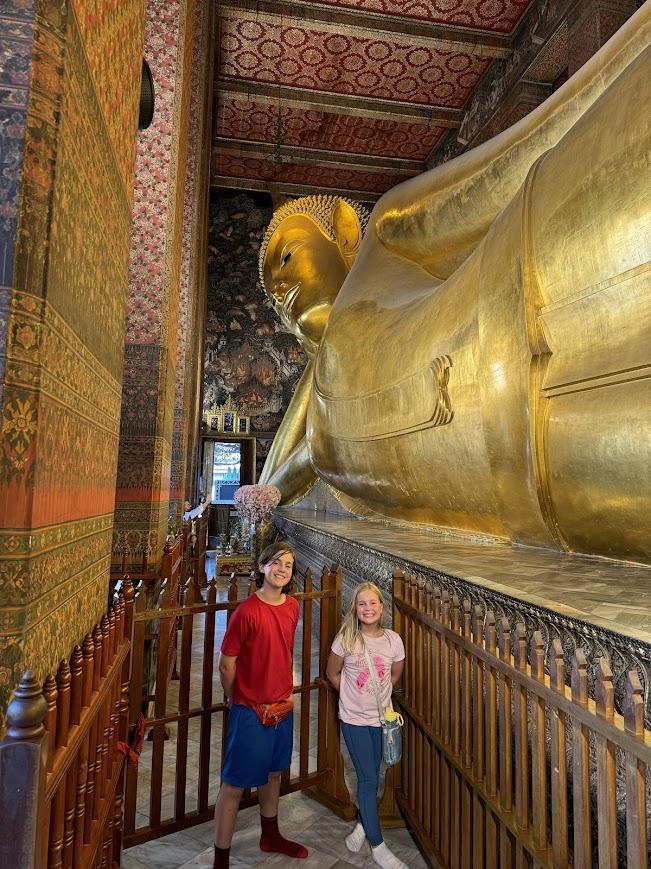
First off, we saw one of the icons of Bangkok: the 15 meter tall, 46 meter long Reclining Buddha. It is located at Wat Pho, which has the largest collection of Buddhas in Thailand. Even in such a large collection, the Reclining Buddha definitely stands out. Standing next to it, I was amazed that I was only about as big as one of its toes! 😅 The Buddha is laying down, showing the moment when he is about to enter Nirvana (meaning his stage of death). The statue is made of bricks covered in plaster, and the whole thing is coated in gold leaf. In the temple housing this humongous statue, there are also 108 little buckets, which represent the 108 characteristics of the Buddha. You can pay to get a little tray of coins and put a single one in each of the buckets, which is supposed to give you good luck. James & I spent time distributing coins and it’s actually pretty fun!
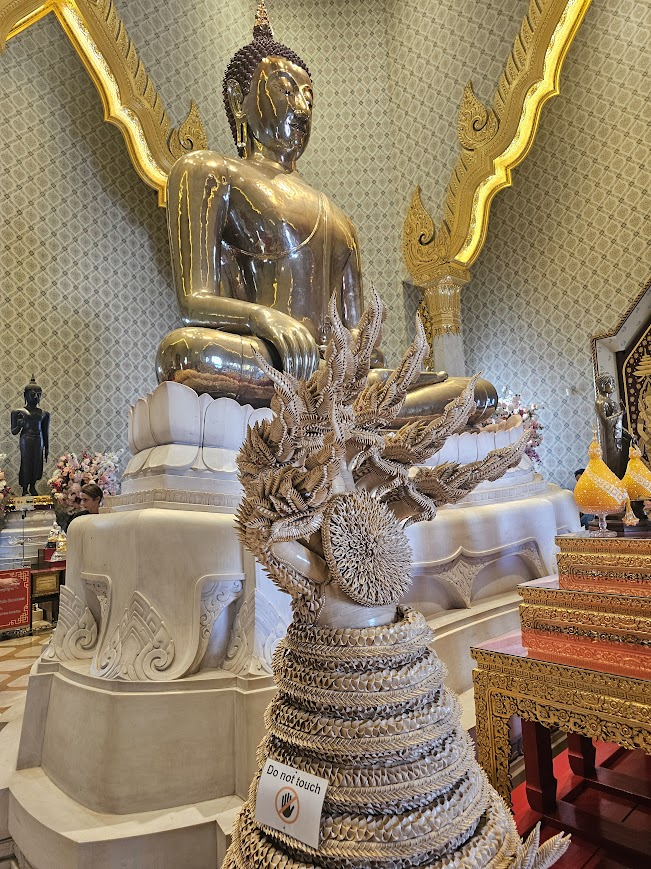
In Chinatown, we encountered the Golden Buddha of Wat Traimit, and we had to walk up a lot of stairs to get to the top of the temple to see it! This Buddha isn’t as large as the Reclining Buddha, but it’s still pretty big and weighs 5,500 kilograms. Some people think that it could be as old as from the 13th or 14th centuries, but we don’t know for sure. At an unknown time it was covered in plaster to hide its value and prevent enemies from stealing it, and in the 1800s it was moved to Bangkok. However, they didn’t discover that the Buddha was made of gold until 1955, when the statue was dropped while it was being moved to a new temple. The plaster cracked and revealed the beautiful gold insides that had been hiding for many years. That might be the only time that breaking a Buddha has turned out well! 😂
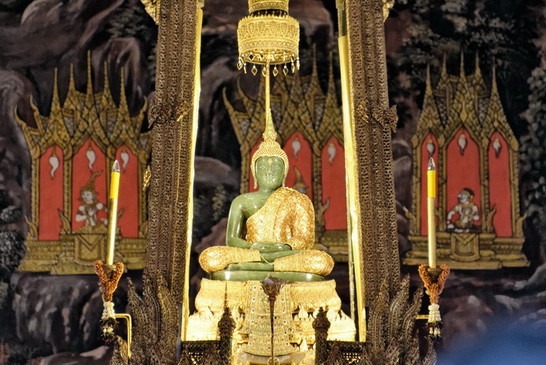
Lastly, we saw the Emerald Buddha. It’s not actually made of Emerald, it’s green Jasper, but they named it that because green Jasper looks rather like green Emerald. Again, it is uncertain where it came from or who made it. Over a few hundred years it may have passed through several countries, including Cambodia, Laos, Sri Lanka, and India. However, ever since 1784 it has been in Bangkok, in a special wat that was built for it. The people of Thailand believe that it brings them good luck and prosperity. This Buddha has different outfits for Bangkok’s 3 seasons - hot, cool, and rainy. It is looked after by Thai kings and only they can change the Emerald Buddha’s clothes.
There are certainly tons more Buddhas in Bangkok, but I liked these three the most!
Caitlin:
Thailand is where Sean and I went for our honeymoon, one year after we got married. Most of that trip was to the (gorgeous) islands in the south of the country, but our final few days were in Bangkok and we have fond memories of that.
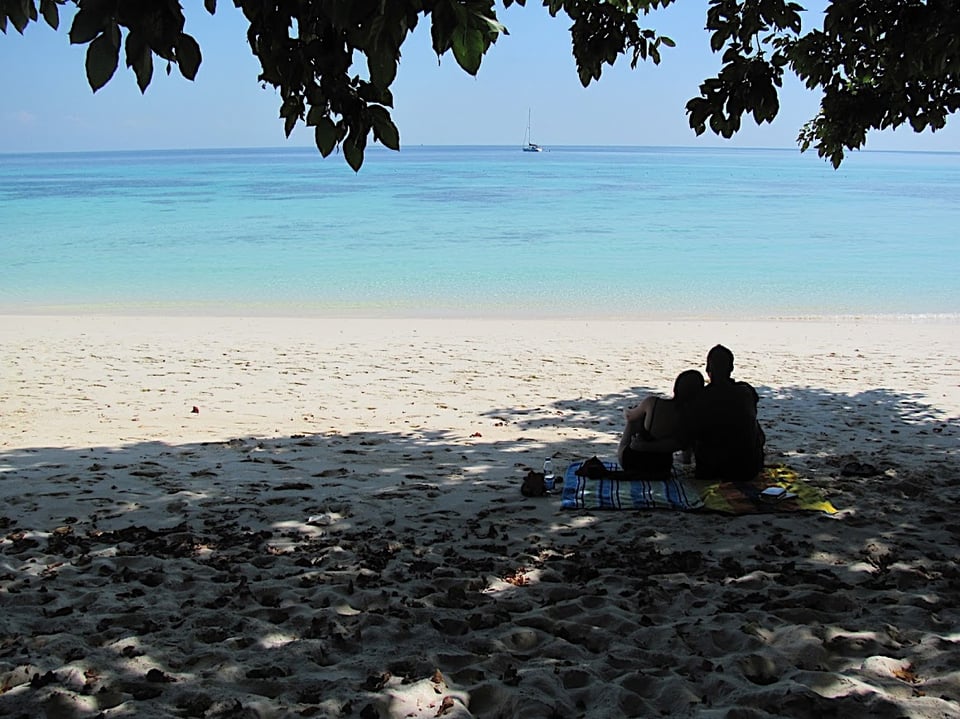
Visiting with the kids was a very different experience for several reasons. Firstly, when Sean and I came it was in mid-December and temperatures were warm but fairly mild. When we decided to come with James and Abby in March this year, we knew springtime temps would be warmer, but vastly underestimated by how much. It hovered around 100℉ every day that we were in the city. We’ve been getting a lot of that while we’ve been in SE Asia and unfortunately I can’t say that my body adapted to the temperatures gracefully. Within minutes (and I mean that literally) of stepping out the door we all had sweat dripping down our backs. The only saving grace for me was that we were always wearing “temple clothes,” meaning long pants and tops that covered your shoulders. My top of choice for these occasions is usually a lightweight gauzy shirt over a tank top or tshirt, in the (sometimes vain) hope that the sweat would only show through the bottom layer of shirts. I can’t fathom how people survive the hotter weather in the summer. If you’re planning to head to Bangkok, I highly recommend going in the mildest temperatures possible.
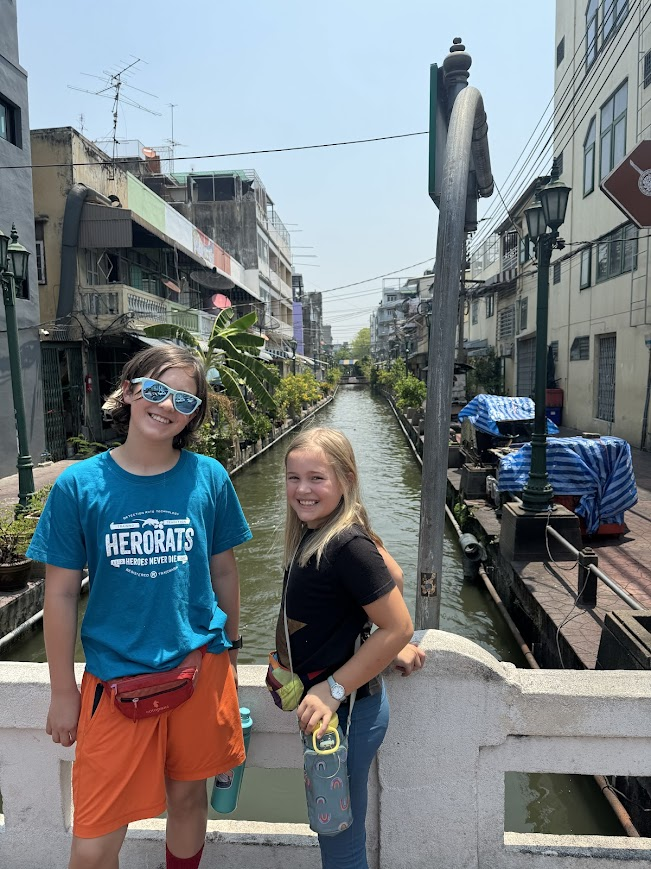
Another aspect that struck me was how much quieter the city seemed to be. I didn’t have a clear memory of the city layout from our first trip, but this time we planned to be within walking distance of the major tourist attractions like Wat Pho, Wat Arun, and the Grand Palace. It was great for visiting the sites, but I couldn’t shake the feeling that this wasn’t Bangkok as I remembered it. Then later in the week we were in Chinatown and the streets were jammed with people walking, street food carts, and souvenir stands. This was how I remembered Bangkok! We actually walked past the hotel where Sean and I had stayed almost 15 years ago, and I realized that maybe it’s less that my memories are outdated than that I myself am. As much fun as the chaos of Chinatown was, I was happy to be staying in a quieter hotel in a quieter neighborhood. It was a different experience to be on the quieter side of town, but a better fit for my life now.
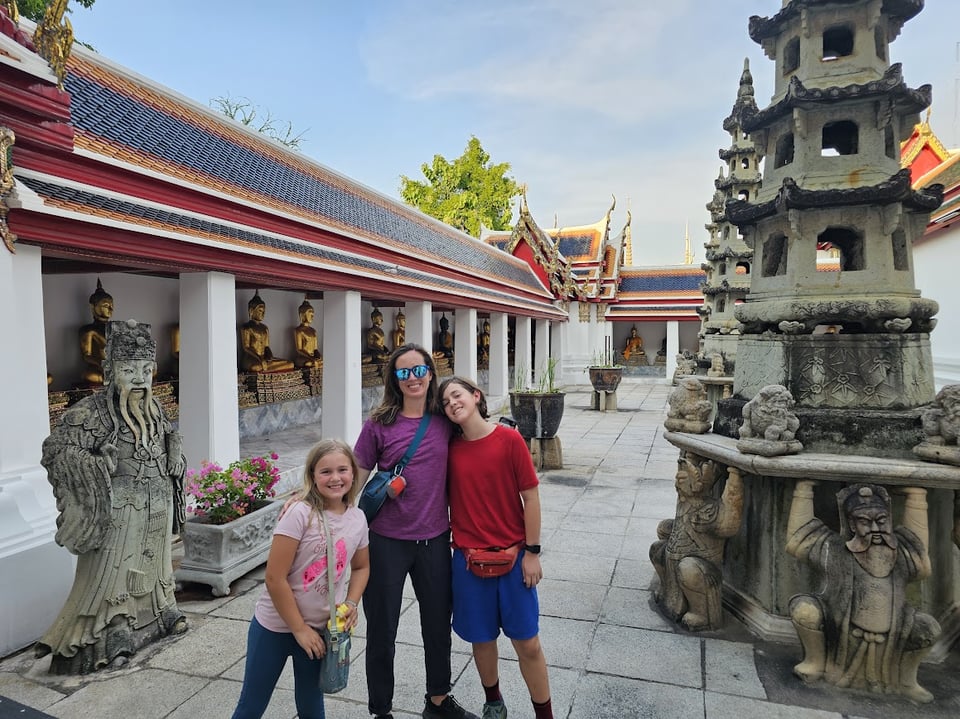
Finally, one big difference was that this time around Sean and I had to plan for more people than just ourselves. We had the kids with us, of course, but we also spent a fair bit of time with the Pauls again this week and their friends (our new friends!) the Johnsons. We weren’t staying together, but many of the things we wanted to do in Bangkok overlapped, so we were able to enjoy some more time together. It can be a tricky thing to meet the needs of everyone in a larger group, but luckily everyone got along well and we even managed to find seating for 12 for dinner! It was our fourth week traveling with Aviva, Chris, Sabian, and Aurelia, and we all feel so lucky to have had this time together to connect. We were sad to say goodbye to them on our last night in Bangkok, knowing we won’t see them until the fall. Sean and I had so much fun alone as just a couple, but it’s a wonderful gift to have been able to create memories and share the last month with our kids and friends.
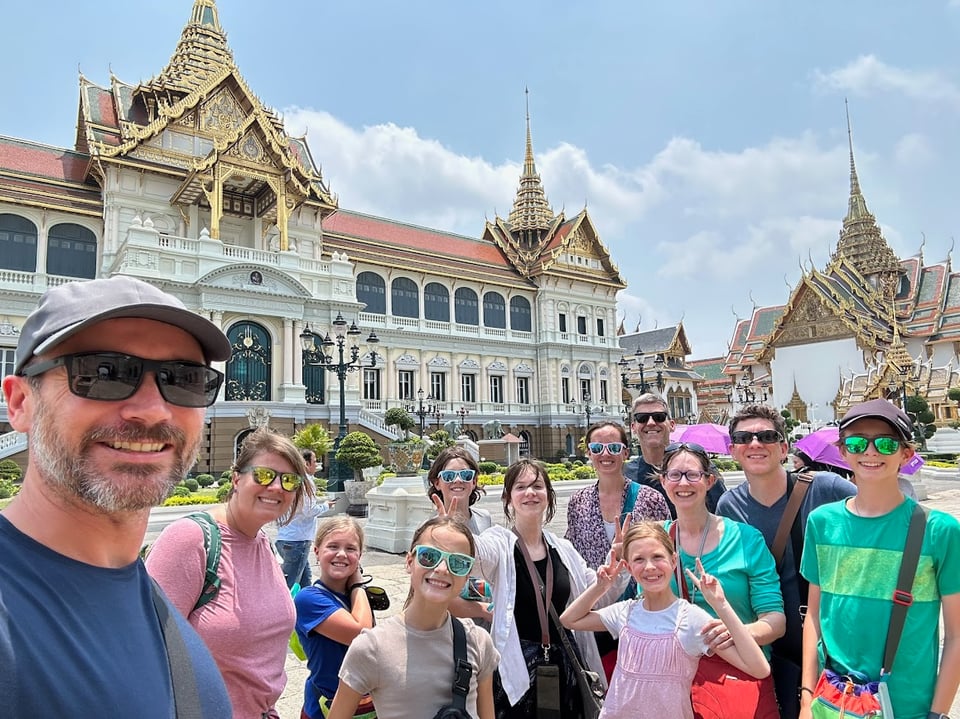
James:
The Hagia Sophia in Istanbul stands as a beacon of peace and prosperity for the people of its city. It was first built by the Eastern Roman (Byzantine) Empire in 360 AD and served as an Greek Orthodox Church, with no minarets and a wooden roof. If everything had gone to plan, it might have stayed that way. However, history doesn’t like plans. In the year 404 a massive riot broke out due to political unrest in the Emperor Arkadios’ family. During the course of this riot, the first Hagia Sophia was burned to the ground. His successor, Theodosios II, began construction on a second one, and it was completed in 415 AD. He had made some architectural changes, but the basic look remained the same. However, he kept one fatal flaw: the wooden roof. By 532, the kingdom was ruled by Justinian I, who was admittedly not a “people person,” even for a Roman emperor. His people turned against him in a series of excessively bloody riots called the “Nika revolts’, and the poor HS was made a target again. It wasn’t completely destroyed in the fire they set, but it was bad enough that Justinian had it torn down and then rebuilt to his standards. This time, it was completely stone with a domed metal roof, and this version from 537 AD is what you still see today.
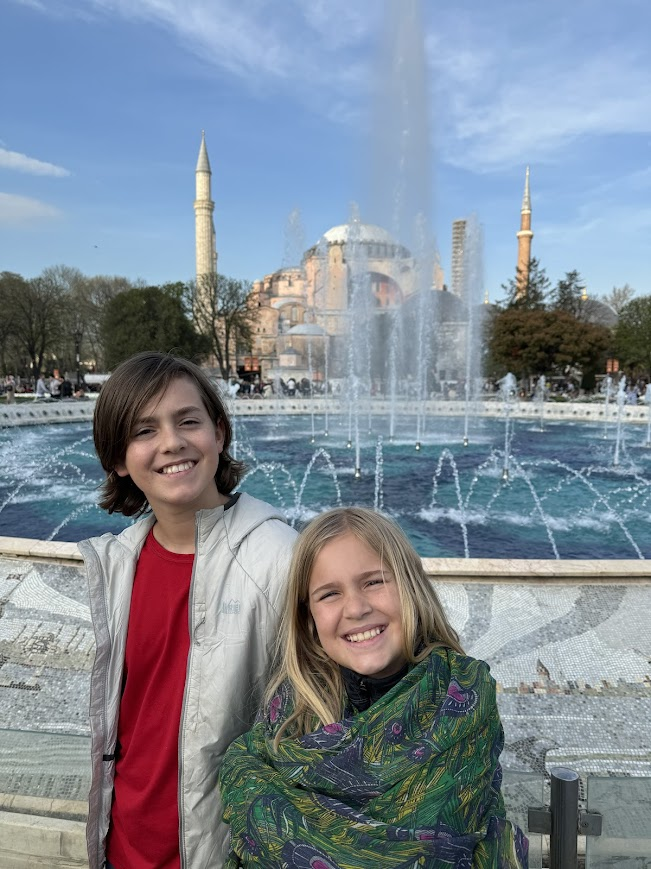
But the mosque’s story wasn’t over yet, not by a long shot. Istanbul was placed very briefly under Roman rule in the 1200s during the Crusades. The Byzantines managed to take back their city, but were weakened so badly that when the Ottoman Empire attacked, they had barely any strength left. Mehmed the Conqueror was now their new leader. The Ottomans were firm followers of Islam, so they converted the Hagia Sophia into a mosque. When they did, they added some new structures, including its still-standing four minarets. Once all those changes were made, Istanbul slowly settled into an era of peace. There were some minor hitches along the way, including the fall of the Ottoman empire after WWI (they rebounded from that one by establishing the Republic of Turkey in 1926) but the Hagia Sophia saw the city through all of its dark times and gave them hope.
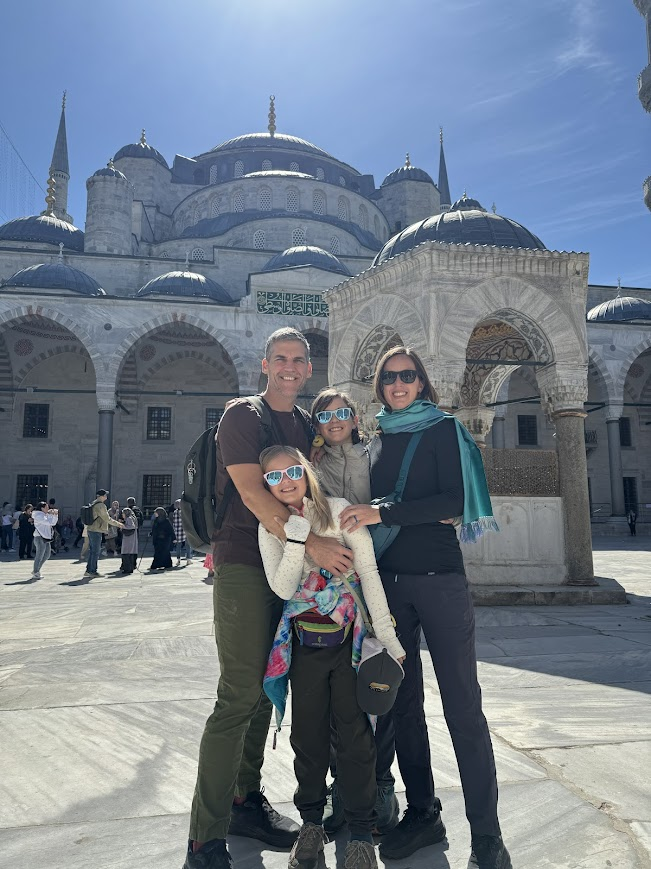
In 1935, Turkey’s government decided that for the sake of tourism, the Hagia Sophia was to be made into a museum. This was a huge mistake - the tourists flooding through the museum were dealing minor structural damage to their holy place. They did it through scuffing the floor with their feet and wearing down the stone with the oils in their hands. The government reclassified the Hagia Sophia as a mosque in 2020, and it has remained as such ever since.
I loved learning about the fascinating history of the Hagia Sophia, and I hope you did too!
See you next week!
Sean, Caitlin, James, and Abby
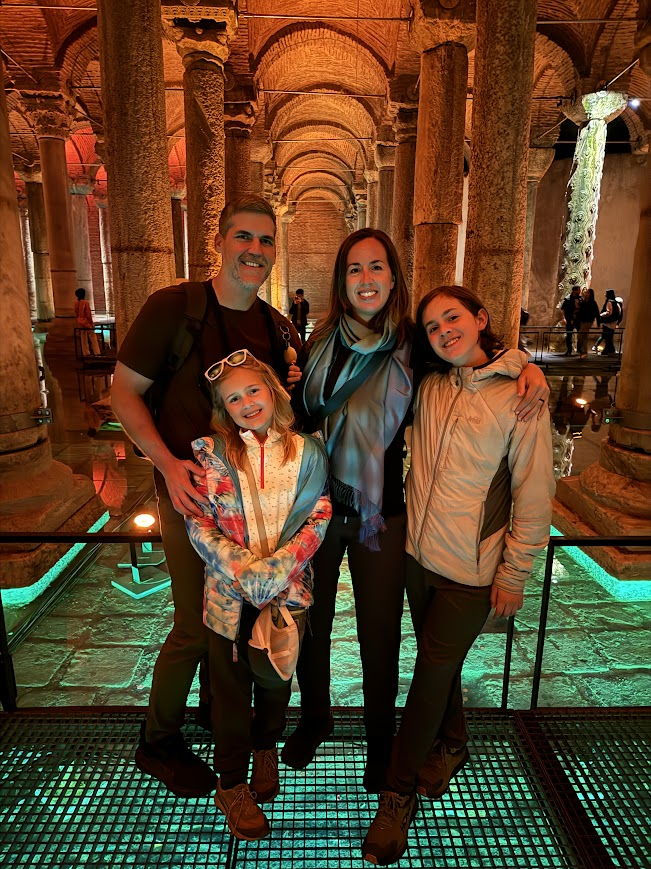
Catching up? Read week 1, 2, 3, 4, 5, 6, 7, 8, 9, 10, 11, or 12.